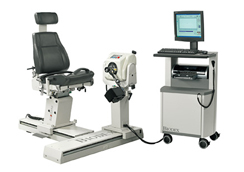
Redesigned seat accommodates athlete to pediatric applications, however does not lay fully flat.
Easier to use Software features include:
- End by % of fatigue in Biofeedback, an exercise bout can be completed when the work for a repetition has dropped below a threshold (such as percentage of work)
- Rehabilitation Progress Report that plots strength, pain, ROM and other defined measurements…and much more Touch-screen… see it, select it, adjust it.
- Simplified patient positioning with on-screen audio and visual aids
- Wide Range of Normative Data athlete to paediatric
Reduced floor space Improved Work Simulation exercises
Good after-sale support, installation and continuing education programs
Isokinetic Resistance Mode
The Isokinetic Resistance mode for testing and rehabilitation is totally accommodating throughout the entire range of motion. Biodex’s unique impact-free acceleration and deceleration eliminates joint trauma, allowing patients to exercise and be tested at more functional speeds. Resistance continuously matches effort, accommodating to variations in patient force output due to weakness, pain or fatigue at specific points in the individual’s range of motion. Research along with over 25 years of clinical application has demonstrated that isokinetic resistance is a safe, objective means to quantify physical impairments with a high correlation to function. Isokinetic testing is the standard for muscle and joint assessment. Applied torque response ensures that the patient’s limb velocity increases or decreases in proportion to the torque applied during acceleration and deceleration, enabling neuromuscular control measurements. Choose concentric and eccentric contractions to perform isolated polymetric exercises.
– Concentric torque up to 500 ft-lb (680 Nm) and eccentric torque up to 400 ft-lb (542 Nm) accommodates the demands of high performance athletes and sports medicine researchers.
Reactive Eccentric Mode
The Reactive Eccentric mode for submaximal neuromuscular re-education in the early phases of rehabilitation The System 4 responds only to the patient’s force output. To initiate movement, the patient must produce and maintain a pre-determined minimum amount of force. This loads the muscles surrounding the joint, producing a pre- load, thus stabilizing and protecting the joint. Eccentric torque up to 400 ft-lb (542 Nm)
– Accommodates the demands of today’s athletes and sports medicine researchers.
Passive Motion Mode
The Passive Motion mode is a multi-function modality. Unique control properties allow for early intervention in all patients throughout all phases of rehabilitation. Torque limits can be set as low as .5 ft-lb (.7 Nm). If a torque limit is exceeded during an eccentric contraction, the System stops. Once the patient’s torque output drops below the prescribed limit, movement is allowed. This unique capability allows patients to work safely at definitively prescribed sub-maximal force levels while combining isometric, concentric and eccentric contractions for:
– decreasing joint effusion
– increasing range of motion
– developing strength Passive speeds can be set as low as .25 degree per second and as fast as 300 degrees per second. The very slow speeds allow for overcoming the natural stretch reflex. Ideal for proprioceptive testing in early stages of rehabilitation. Biodex software includes specific protocols for active and passive joint repositioning. Higher speeds in passive mode are ideal for active assistive exercise.
Isometric Mode
The Isometric mode is commonly used pre and post operatively or when pain associated with motion is a factor. Isometric contractions are effective at developing strength and decreasing joint effusion while avoiding painful points in the range of motion. Biodex software automates the rehab process with automated multiple angle isometric protocols. Work the agonist, antagonist or both muscles at specified joint angles.
Isotonic Mode
The Isotonic mode allows velocity to vary while providing inertia-free constant force and concentric or eccentric muscular contractions. Higher performance:
– Isotonic force to as low as .5 ft-lb (.7 Nm) = 6 inch pound; and as high as 400 ft-lb (542 Nm) Allows for functional task simulation when using work simulation tools, e.g. turning a doorknob. Because the force is selected, the Isotonic mode also provides protective pre-loading of the joint prior to movement. Ideal for work simulation. Constant force muscle loading is considered functional, as natural activities normally involve moving a constant weight object at varying velocities.
Enjoy complete freedom in planning the mode and level of clinician interaction that works best for each patient. Touch panel controls give clinicians the hands-on ability to adjust torque, speed, range of motion and other clinical parameters in real time.
The Biodex System 4 also allows clinicians the option to select automated test and exercise sessions. Any sequence of modes can be employed automatically.
Customized Motor Control
The Researcher’s Toolkit Software (optional) allows for advanced specialized system control. Ideal for researchers investigating neuromuscular performance.